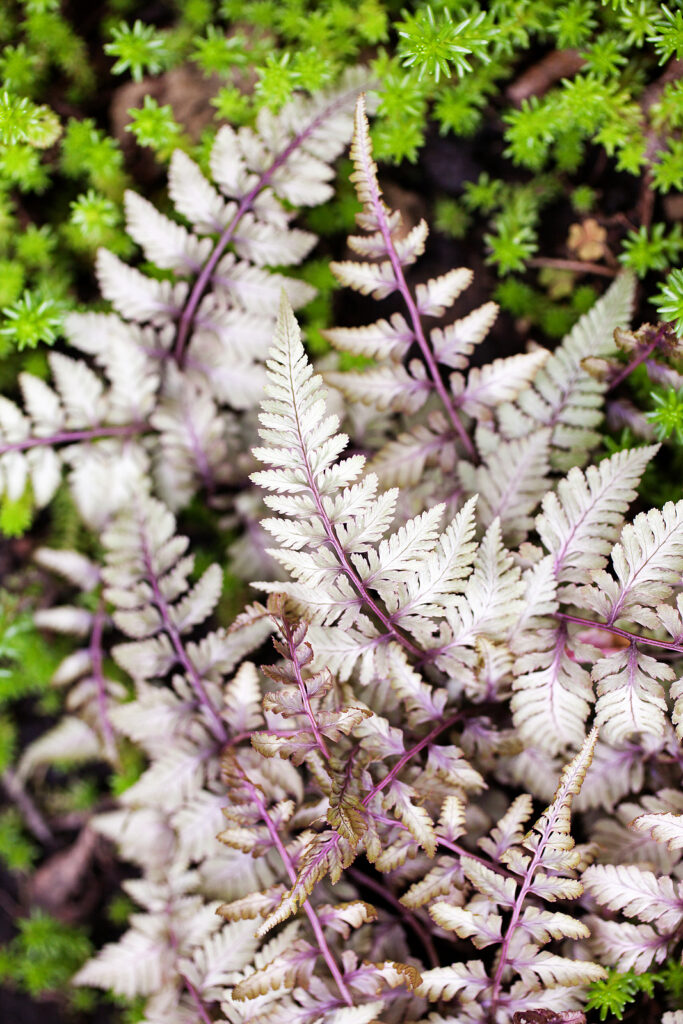Athyrium — commonly called lady ferns or painted ferns–are ferns with lance-shaped, pinnate fronds that can be silvery gray-green or mid-green. Athyrium grows from creeping red-brown rhizomes. Athyrium forms compact mounds or clumps or grow erect from the crown.
Athyrium grows widespread in the temperate regions of the Northern Hemisphere. They grow best in partial to full shade in moist, well-drained soil that is rich in organic matter.
Athyrium can be used as a groundcover in shady beds and borders and in woodland settings. Where Athyrium is not hardy it can be grown as a houseplant.
Athyrium is a genus of 180 species. Just a few are commonly grown in gardens.

Get to know Athyrium
- Plant type: Terrestrial, deciduous perennials
- Growing zones and range: Zones 3 to 8
- Hardiness: Hardy to Zone 3; grow as a houseplant where not hardy
- Height and width: 8 inches (30cm) to 3 feet (1m) tall or more and half as wide depending on the species
- Growth rate: Slow
- Form and habit: Either compact, mounding clumps, or erect crowns
- Foliage: Handsome fronds are once-, twice-, or thrice-cut or divided in a pinnate fashion
- Uses: Ground cover or accent
- Garden companions: Primrose or dwarf astilbe
- Common name: Lady fern, painted fern
- Botanical name: Athyrium
- Family name: Dryopteridaceae
- Origin: Moist woodland and forest in temperatre and tropical regions around the world.
Where to plant Athyrium
- Plant Athyrium in full shade or filtered light; develops best color in filtered light.
- Plant Athyrium in well-drained, humus-rich soil; work plenty of organic matter such as compost or chopped leaves into the soil at planting time.
- Plants have somewhat brittle fronds that break easily, so keep them away from high-traffic or windy sites.
When to plant Athyrium
- Set Athyrium in the garden in spring or autumn.
- Start seed indoors in spring.
Planting and spacing Athyrium
- Plant Athyrium 1 foot (.3m) apart for colorful ground cover and 2 feet (.6m) apart for accent.
How to water and feed Athyrium
- Keep Athyrium continuously moist, providing ample water.
- Water Athyrium deeply during dry weather.
- Feed Adiantum with an all-purpose organic fertilizer in spring.
How to care for Athyrium
- Leaves of Athyrium turn brown after repeated frost. Leave dead fronds on plant to provide mulch and to shelter emerging fronds in early spring, then cut back.
Athyrium pests and diseases
- Athyrium is prone to rust.

Athyrium propagation
- Propagate Athyrium by dividing old clumps in early spring.
- Sow spores as soon as ripe at room temperature.
Athyrium varieties to grow
- Athyrium filix-femina, Graceful lady fern, is a vigorous and up to 3 feet (.9m) tall, but looks lacy and delicate. It is tolerant of dry soil and easy to grow. Rootstock rises up on older plants to make short trunk. Vertical effect; narrow at bottom, spreading at top. Thin fronds, finely divided. Vigorous; can be invasive. Tolerates full sun in constantly moist soil. Specialists stock many varieties with oddly cut and feathered fronds. In ‘Frezelia’, divisions of fronds are reduced to balls; fronds look like strings of beads. ‘Vernonia Cristatum’ has crested and feathered fronds.
- A nipponicum ‘Pictum’ (A. goeringianum ‘Pictum’), Japanese painted fern, fronds grow 1.5 feet (.5m) long, making a tight, slowly spreading clump. Leaflets are purplish at base, then lavender, then silvery greenish gray toward ends. Zones 4 to 8.
- A. otophorum, English painted fern, actually a native of the orient. It resembles Japanese painted fern, but its dark green fronds have a reddish or purple midrib.
- A. pynocarpon, Glade fern, Silvery spleenwort, attractive rosette-forming deciduous fern with once-divided fronds to 4 feet (1.2m) long. New spring fronds are silvery light green; they turn darker in summer, then russet before dying back. Tolerates full sun in constantly moist soil.















